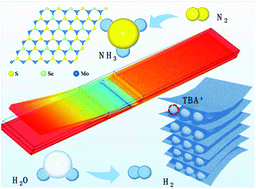Electrochemical exfoliation of ultrathin ternary molybdenum sulfoselenide nanosheets to boost the energy-efficient hydrogen evolution reaction†
Abstract
Developing low-cost and highly efficient transition metal dichalcogenides as alternative electrocatalysts has become an urgent need for the hydrogen evolution reaction (HER). However, the inert basal planes of transition metal dichalcogenides severely suppress their practical applications. Herein, we developed ultrathin ternary molybdenum sulfoselenide (MoSexS2−x) nanosheets by using the cathodic electrochemical exfoliation approach in non-aqueous electrolytes. The exfoliated MoSexS2−x nanosheets demonstrated high structural integrity with lateral dimensions up to ∼1.5 μm and an average thickness of about 3 nm. Owing to the unique ultrathin structure and immensely exposed active sites, the ternary MoSexS2−x nanosheets supported on Ni foam demonstrated a greatly enhanced electrocatalytic activity for the HER in 1.0 M KOH with an overpotential of 123 mV at a current density of 10 mA cm−2 and high stability, superior to majority of the previously published MoS2-based electrocatalysts. Furthermore, the ternary MoSexS2−x nanosheets as a highly active bifunctional electrocatalyst contributed to enhanced energy-efficient hydrogen production and electrocatalytic synthesis of ammonia.



 Please wait while we load your content...
Please wait while we load your content...